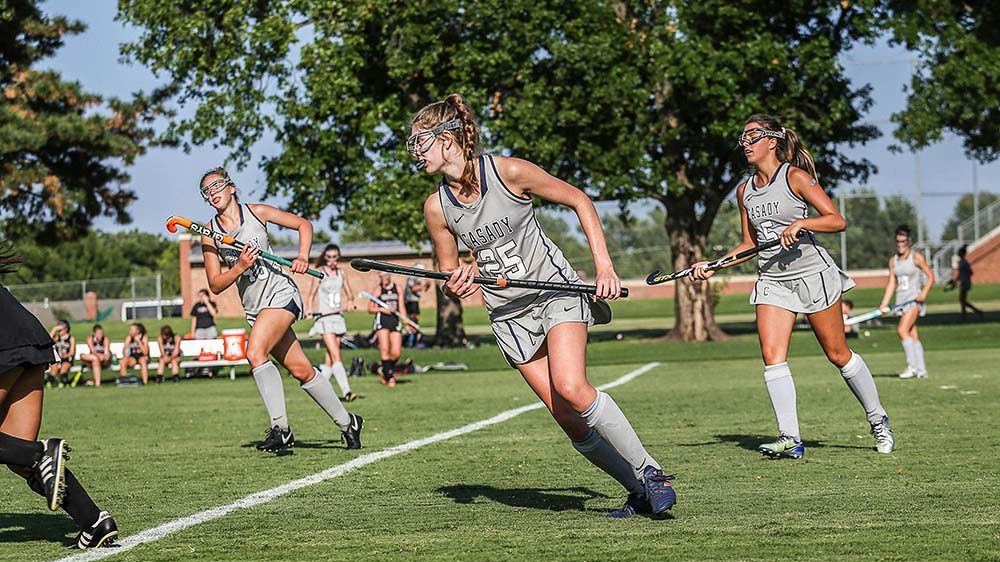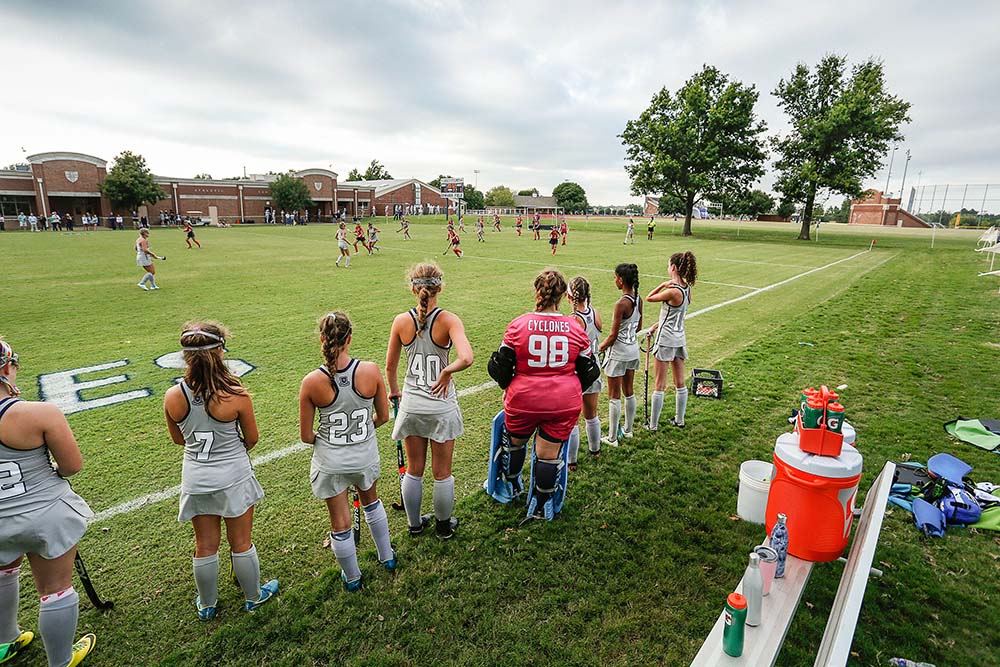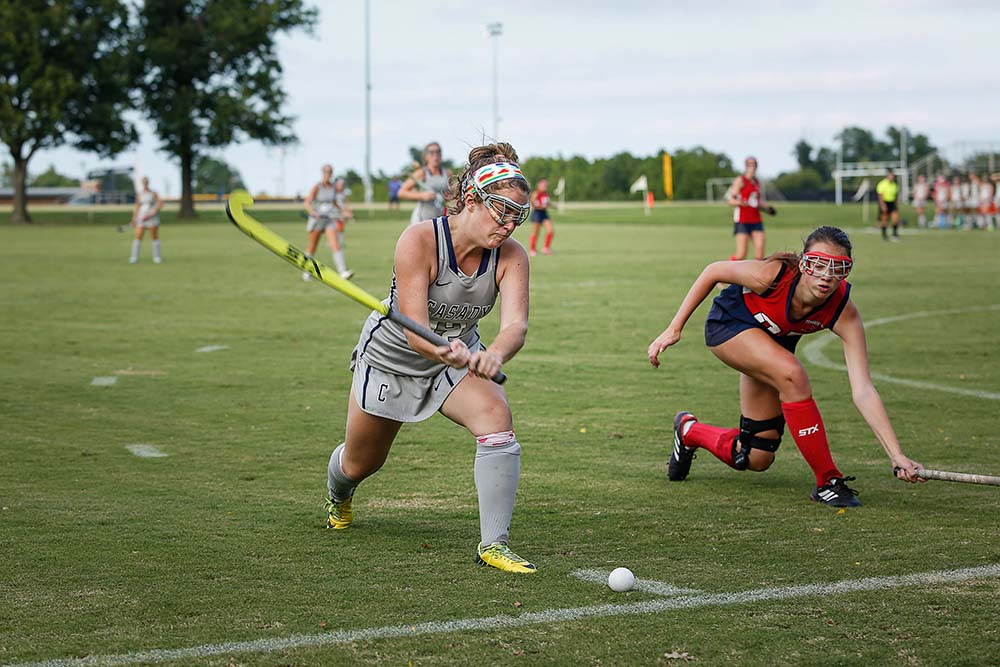
Fall athletics in Oklahoma high schools revolve around football, with cross country, volleyball and fast-pitch softball vying for a distant second in terms of fan interest.
Frequently overlooked in this part of the country is a sport that, like football, unites fearlessness, eye-hand coordination, speed, strength, endurance, finesse, explosiveness and aggression. And it’s played by young women.
“Field hockey is a bit dangerous because it’s fast and you have a stick and a hard ball,” says Carla Lane, coach of Oklahoma City Casady School’s team since 2007. “It’s fun. It’s a blast. It’s challenging. You have to work at it to be successful. Those elements are appealing to athletes. If you’re a competitive kid, you play field hockey.”
Holland Hall coach Christy Utter, who won NCAA championships in 1995 and 1996 at the University of North Carolina, concurs.
“Field hockey brings in all the best parts of athleticism: endurance, quickness and speed,” the Tulsan says. “And you can continually improve in all these areas.”
Holland Hall sophomore Phoebe Beckwith, a forward, says field hockey “is the toughest sport to play because you have to stay so low to hit the ball. It takes a lot of control; you often have to squat while you run.”
In the summer, during pickup workouts, Lane allows boys who excel in other sports to play field hockey with her team.
“The boys often complain the next day that they used muscles that they’ve never used before,” she says with a laugh.
Female empowerment
Throughout the world, both genders compete in field hockey. However, in the United States, women primarily play it. While the sport is common in public schools in the East, it’s most often played at private schools in the Midwest and Southwest.
“It’s unique in that we’re not compared to boys teams,” Lane says. “It becomes something that the girls own themselves and are proud of. Having something of their own makes it special.”
Ellen Payne, one of Lane’s Casady products and a fifth-year senior back at defending NCAA champion North Carolina, agrees that field hockey empowers young women.
“Women’s strengths are shown off now and that’s cool,” she says. “That wasn’t always the case.”
Beckwith agrees.
“It’s empowering because of the strength and speed you need to play,” she says. “You have to be tough and that’s a really good thing to have.”
Payne began playing at UNC as a preferred walk-on, but she worked her way into a scholarship her junior year. Field hockey, she says, often presents more scholarship opportunities because most female athletes look to compete collegiately in soccer and basketball.
The off-field benefits can help financially, too.
“While interviewing for jobs, field hockey often comes up,” says Payne, who already has a job lined up with a financial company in Dallas after she gets her degrees in economics and management in society. “You learn to express yourself and get feedback, so that’s a valuable talking point when it comes to character and the ability to work with others.”
Multi-sport preference
So-called three- or four-sport girls often excel in field hockey because the game requires elements common in other athletic events.
“The power center for speed and explosiveness is in the hips, so that draws a lot of athletes who are fast and strong in other sports,” says Lane, a 1991 Casady graduate who played at DePauw University. “You have to bend your knees and flex your hips to strike the ball effectively.”
At Casady, Payne played soccer and softball and ran track. Junior Grace Peterson, a field hockey midfielder and forward at Holland Hall, also competes in basketball, track and field, and skeet shooting. Dutch teammate Beckwith runs track and plays soccer. Utter, a 1992 Holland Hall graduate, competed in basketball and track and field.
UNC coach Karen Shelton, who has won seven national titles, actively recruits and prefers young women who are all-around athletes.
“That cross-training is really good for field hockey,” Shelton says. “With Ellen [Payne] and Christy [Utter], I was able to transform their being good in many sports into being great hockey players.”
Shelton adds that Utter and Payne, from a state that is not a field hockey hotbed, have a drive that “makes them open to learning and adapting and improving their game. Attitude is everything. That’s why Christy was one of the greatest captains we’ve ever had … coming in unheralded and relatively unknown. Ellen has those same qualities.”
Playing multiple sports also “shows that you’re coachable,” Payne says. “In field hockey, you have to have an eye for the field and athletes who play more than one sport can see the whole field or court and adapt.”
Teamwork as the priority
Everyone involved in field hockey brings up the importance of operating as a cohesive unit … and the mental and social advantages that come from setting aside one’s personal agenda for the team.
“You can’t win with just one or two good individuals,” Utter says. “You have to understand your role on the team and stick to it, even if it’s not the position you think you should be in.”
All team sports require selflessness, but the physicality of field hockey often creates unique bonds.
“Field hockey is different from any other sport; my heart’s in it because of my team,” Peterson says. “I love my team. We’re all doing it together, even if it’s 100 degrees outside. If someone’s down, someone else picks her up. The team gives me a positive outlook.”
Beckwith adds: “The team is a family. I’ve definitely learned to be mentally tough and to keep going when things are difficult.”
Utter, Holland Hall’s coach since 2012, stresses the personal growth that she sees in her players. Oklahoma field hockey players frequently compete out of state to find different teams to play, so travel allows them to experience different cultures and worldviews.
“You meet people from all walks of life,” she says. “In Pennsylvania, New York, New Jersey and other eastern states, it’s a blue-collar sport played in public schools.
“On the social level, especially in ninth and 10th grade, players are allowed to mature in a sport that emphasizes teamwork, so you see and appreciate what others do as you mature.”
Payne declares that her UNC teammates are her best friends.
“You’re working toward a common goal and we spend obscene amounts of time together,” she says. “You can’t avoid anything when it comes to problems.”
Lane adds: “Field hockey shows a lot of personal commitment and sacrifice for the team. It’s an unselfish game.”
Self-confidence
Utter and Lane, as coaches, see benefits that last long after field hockey games end. Utter touts the instantaneous problem-solving required in the sport.
“You have to learn to move on immediately from your mistakes,” she says. “You always ask yourself, ‘What do I do next?’ The kids who become mentally strong because of this are the better players. You have to find your way through practices and games in hot weather.
“You build a lot of self-confidence in field hockey.”
Lane puts it another way.
“When we present to players what we want to accomplish at the beginning of the season, they’re often shocked,” she says. “But when we break it down, they see it’s possible. So, when they get another challenge in life, which might seem impossible at the moment, they know they can accomplish just about anything.”
FIELD HOCKEY OUTSIDE
OKC AND TULSA
Holland Hall in Tulsa and Casady School in Oklahoma City have played each other in field hockey for more than a half-century … and that was about the extent of the sport in the Sooner State for a long time.
However, field hockey has started to gain attention elsewhere with the recent development of programs in Durant and Norman.
Mike Delloro and his wife, Amanda, began the Texoma Field Hockey Club last year and have added a club team at Durant High School this year.
Kathleen Fitzgerald helps to run two co-ed club teams – the University of Oklahoma and the Oklahoma Wind. At 76, Fitzgerald still competes in field hockey, which she began playing as a high school freshman.
Delloro and Fitzgerald stress the sport’s appeal to all-around athletes.
“We see field hockey as a good cross-over sport,” says Delloro, whose athletic background is in lacrosse, usually played in the spring. “This is a project we’ve wanted to start for a number of years as a complement to the lacrosse program. The field hockey program in the fall is to keep lacrosse girls engaged during the off-season. The interest level is picking up.”
The Texoma squad primarily has girls who are also on the Durant High club team. The former travels great distances, such as to Kansas City and St. Louis, to compete, while the latter plays against Holland Hall, Casady and some private schools in nearby North Texas.
Delloro’s goal is to get field hockey recognized as a club sport for all girls throughout southern Oklahoma … and possibly become sanctioned by the Oklahoma Secondary Schools Activities Association.
“Field hockey is a great bridge sport and complimentary to other sports,” Delloro says. “Some lacrosse girls enjoy field hockey even more because of how free-flowing the game is.”
Fitzgerald, actively involved in the Oklahoma Senior Games as a sprinter, administrates the OU club, a non-varsity team begun five years ago consisting of university students, faculty and staff. A year after that, she and Pakistani native Amir Akhtar started the Oklahoma Wind for players of all ages and skill levels.
Both teams play in out-of-state tournaments, such as in Phoenix and Dallas, and “whoever wants to go can play. Everyone plays about the same amount,” Fitzgerald says. “We’re there to improve our skills, not win gold medals.”
Fitzgerald relishes the intergenerational elements on these club teams.
“We once had an ice hockey player who really knew how to pass,” she says. “He was constantly setting up one of the really young players to score. It was neat to see that.”
In co-ed games, a minimum number of women is needed to field a team. In five-on-five contests, usually two women are required; in 11-on-11, four. However, “each tournament decides how many, so it can vary each time,” Fitzgerald says.
Fitzgerald fell in love with the sport when she went to Andrews Osborne Academy in Willoughby, Ohio. She played collegiately at Ohio Wesleyan and on club teams after graduation in every place she’s lived – the District of Columbia, Florida, Colorado, California and Michigan. She was captain of a U.S. touring team in 1967.
“There’s a joy from playing a team sport and working with others to make something beautiful,” Fitzgerald says. “I want to keep playing. I want that quality of life.”
RULES, TERMS AND ODDITIES
Following are some elements that make field hockey a unique sport.
The stick – A field hockey stick has one flat side and is rounded in the back. Only the flat side may be used during play. Touching the ball with the rounded side results in a penalty and a free hit for the opposing team.
Righties only – Everyone on the pitch uses a right-handed stick because of tradition and safety. The speed of the game and the high densities of the ball and stick create chances for injury. The likelihood of getting hurt increases when a player with a left-handed stick tries to dispossess (tackle) the ball from a right-handed player, so lefty sticks are not allowed since the vast majority of players are right-handed. A lefty player tends to adapt easily because her dominant hand (on top when gripping the stick right-handed) can generate power.
Reverse stick – When the ball goes to the left side of a player, she uses a technique called reverse stick. A player rotates the stick 180 degrees in her hands so that she can use its flat side and stay within the rules. The maneuver takes considerable skill because the lower curve of the stick is designed for the forehand, so reverse stick results in contact with the ball (usually) with just the toe of the stick. A deft player seamlessly dribbles, passes and shoots the ball by using both her forehand and reverse stick.
Scoring arc – A 16-yard arc extends from the net; goals can only be scored from within this area, often called the circle. A shot from beyond the arc must be touched from within the scoring zone in order for it to count as a goal.
No feet – A team’s 10 field players (not counting the goalkeeper) must make sure the ball doesn’t touch their feet … or a penalty is called. However, the umpire has the discretion to overlook an inadvertent touch with the foot if it doesn’t affect play.
High swings and passes – For safety reasons, a player cannot lift her stick above her waist when striking the ball. Passes cannot go overhead unless they’re into clearly open areas and do not endanger anyone.
Self-start – A relatively recent rule change that speeds up the game and reduces injury is the self-start. Before this was allowed, a player with a free hit could only move the ball by passing it to a teammate. A player may still do that, but the new option allows her to begin dribbling upon the umpire’s signal.
Penalty corner – Should a foul occur in the scoring zone, an offensive player passes the ball from the goal line to the arc’s perimeter, where some or all of her teammates stand ready to attack. The defensive team lines up just four field players and the keeper inside the goal. The ball must go outside the scoring area to the offensive team, then re-enter the arc before a shot on goal. A penalty corner is exciting because it combines speed, skill, strategy and aggression by both teams charging at each other in a confined space.
Stance – Field hockey players often have an unusual stance because they have to stay low in order to pass, shoot, dribble or defend in a split second. “It’s a squatting position that’s low – with knees bent and chest up so you can have vision on the field,” Holland Hall coach Christy Utter says. “You have to have your stick down and be in an athletic position.”




























